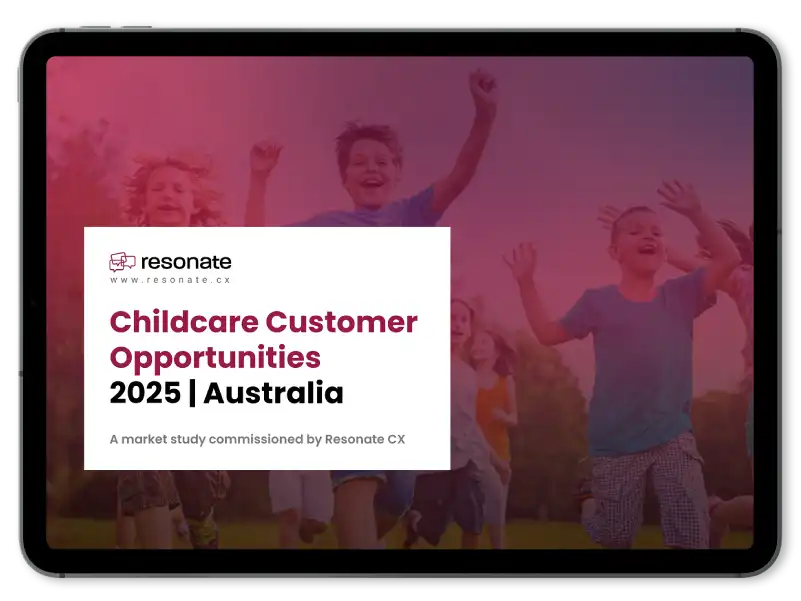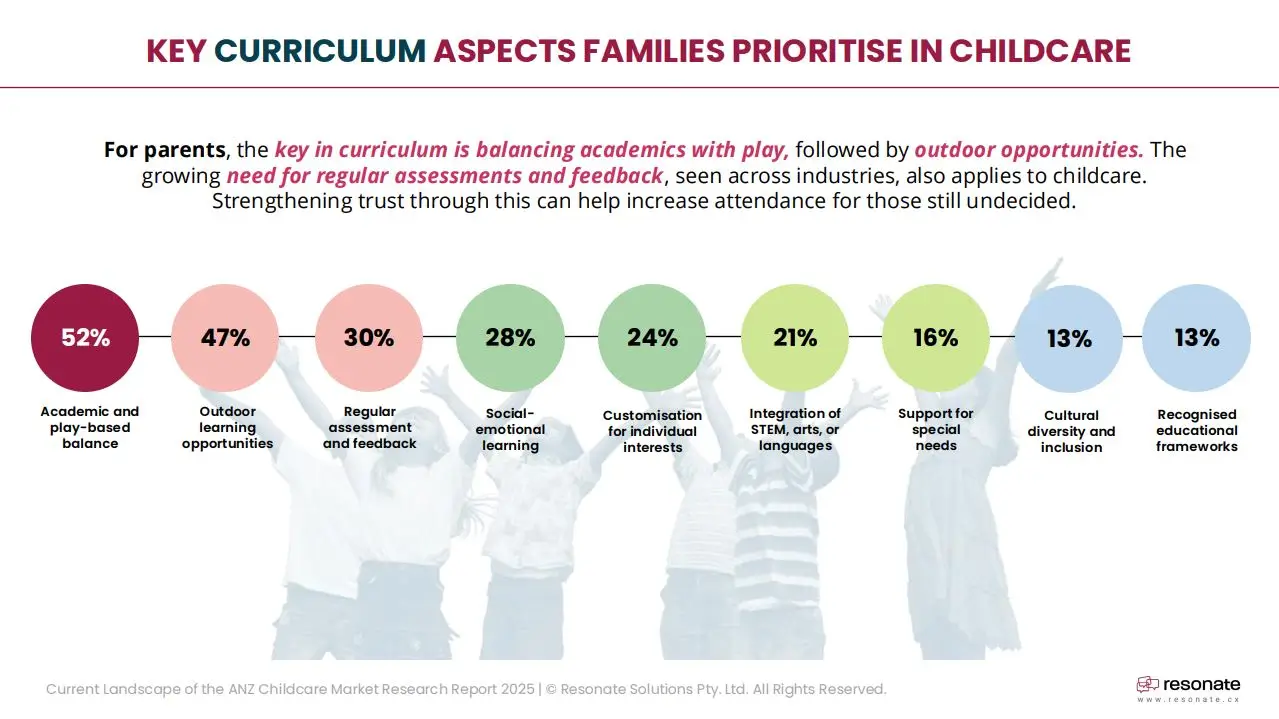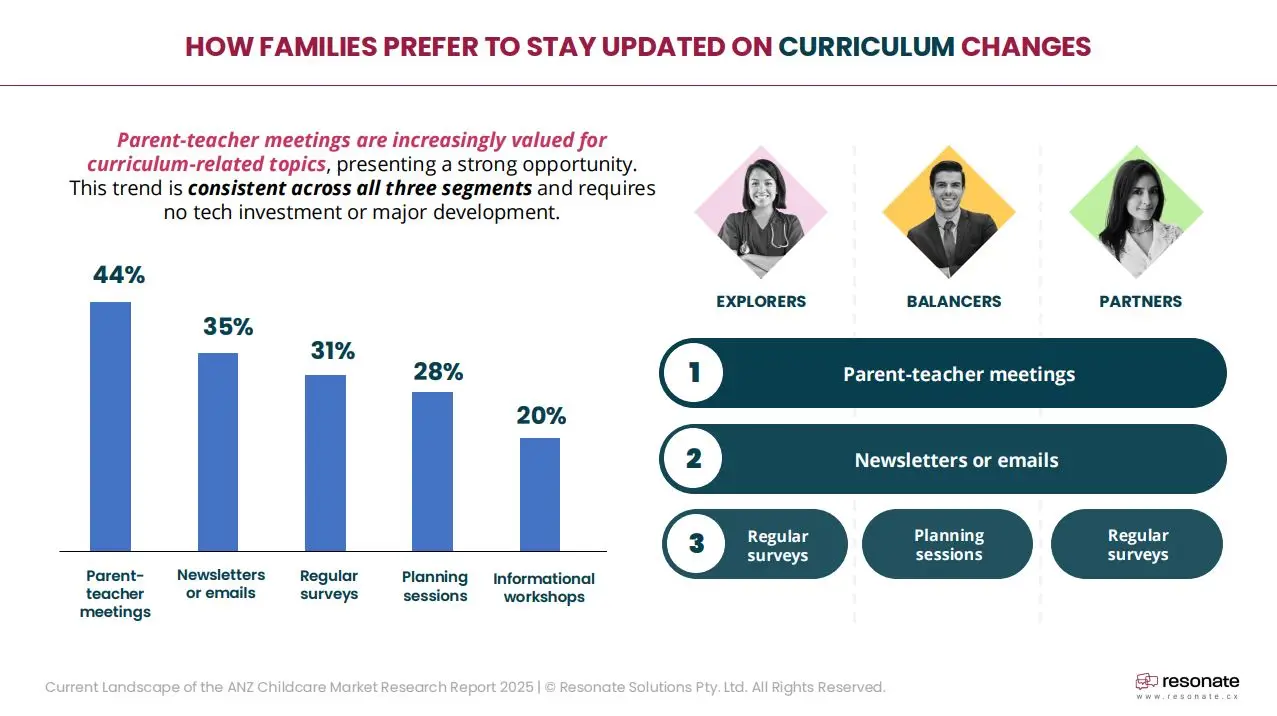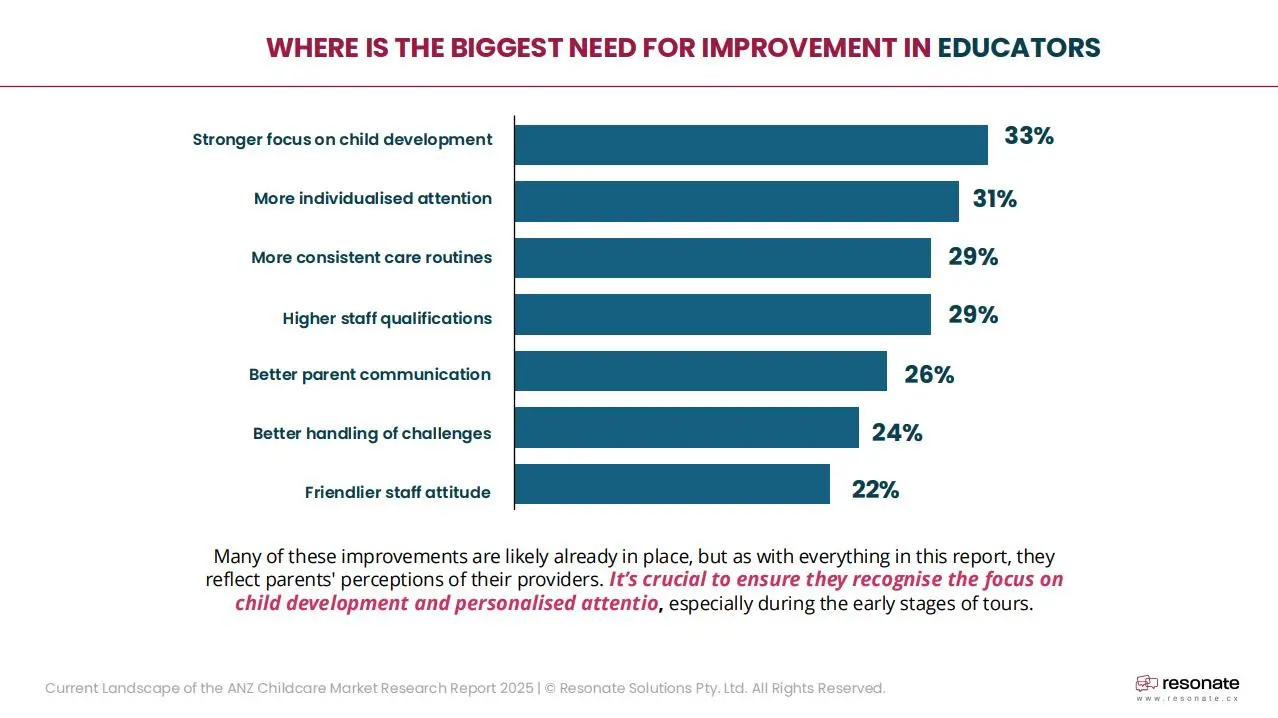TLDR:
- Parents in Australia in 2025 have evolving expectations for childcare, moving beyond just safety. Factors such as educational quality, staff excellence, and strong communication now hold more weight than price when choosing a provider.
- There are three core pillars of a high-quality childcare experience: curriculum, communication, and staff quality. These areas are crucial for providers to focus on to meet parental demands.
- Regular surveys are preferred by 31% of parents for staying informed about curriculum and their child’s progress. This highlights the importance of consistent communication channels.
- Areas for improvement identified include a stronger focus on individualized child development and providing more personalized attention. Consistent care routines are also crucial for parents.
In 2025, choosing a childcare provider isn’t just a matter of location or cost, but a deeply personal decision. Across Australia, families are pausing to ask: Who do I trust with my child? And the answer is no longer just about safety (though that remains non-negotiable). It’s about something bigger.
A recent Childcare Customer Opportunities ANZ 2025 report by Resonate CX highlighted that parents’ expectations are rising. Parents are seeking places that help their children thrive. In fact, factors like educational quality, staff excellence, and strong communication are now outranking even price in importance.
This means that while cost and convenience matter, a truly high-quality experience is about much more than just fees or fancy buildings. Providers that understand and deliver on these core expectations can deepen parent trust and even reduce churn – especially since half of the parents say they would switch to another provider if it offered the features and quality they seek.
So what defines a high-quality childcare experience in 2025? Below, we break down what over 600 parents had to say and what it means for providers aiming to stay ahead.

CHILDCARE Customer Opportunities 2025 | AUSTRALIA
Uncover what parents value most when choosing childcare providers.
Curriculum Matters: The Foundation of a High-Quality Childcare Experience
According to the data, parents are largely satisfied with existing curriculum offerings. Half (50%) of all surveyed parents said they were “satisfied,” and an additional 28% described themselves as “very satisfied.”
But there’s more to the story when we separate out different care types. Families using childcare services reported higher combined satisfaction than those using OSHC (Out of School Hours Care):
- Among childcare users:
– 34% were “very satisfied”
– 44% were “satisfied” - Among OSHC users:
– Only 19% were “very satisfied”
– 57% were “satisfied”
So while satisfaction is strong across the board, childcare services seem to be striking a deeper chord.
What Do Parents Prioritise?
Though families are largely pleased with available childcare curricula, they may prioritise different things:
- 52% valued a balanced mix of academic and play-based learning
- 47% highlighted the importance of outdoor learning opportunities
- 30% prioritised receiving regular feedback on their child’s development
Social-emotional learning, customisation based on individual interests, and integration of STEM, arts, or languages also stood out, but not as much as the leading priorities. Support for special needs, cultural diversity and inclusion, and specific educational frameworks trailed all other priorities from parents’ perspectives.

Although customisation and individualised learning aren’t among the top four stated priorities, many parents still expect curricula to be responsive and flexible enough to support their child’s unique needs, citing “more individualised attention” as a leading area for improvement among educators. With customisation becoming a baseline expectation, childcare services can set themselves apart by actively tailoring learning through differentiated activities and regular updates that reflect each child’s progress.
How Parents Want to Stay Informed: Closing the Curriculum Communication Gap
It’s not enough for schools to offer a great curriculum. More than ever, parents want to understand how curricula are applied and how their children are progressing within those frameworks.
These are the communications preferences of parents across all the identified personas (Explorers, Balancers, Partners):
- 44% preferred parent-teacher meetings
- 35% preferred newsletters or emails
- 31% preferred regular surveys
- 28% preferred planning sessions
- 20% preferred informational workshops
However, the study also revealed that, while parent-teacher meetings and newsletters/emails led across all personas, each persona had preferences for the other communication options. Explorers and Partners, the most committed personas, tended to prefer regular surveys, while Balancers, a high-risk/high-opportunity segment, valued planning sessions.

With that in mind, providers should proactively offer the communication methods that parents are most likely to want. Frequent parent-teacher meetups and newsletters are critical, but offering options for surveys and planning sessions are also important. Having all of these available can increase transparency, building trust and encouraging critical parent engagement in the process. Investing in an education-focused customer experience management platform can also give providers a more refined overview of what different families are looking for.
The Role of Educators: Valued Qualities That Define Great Childcare Staff
What defines a great educator from a parent’s perspective? Qualifications certainly matter, but they’re not what parents tend to rank highest in their list of priorities.
When choosing a childcare service, Australian parents prioritised staff-related qualities:
- 44% valued safe and secure care
- 37% valued friendly and warm attitudes
- 35% valued respect for family values
- 34% valued clear and quick communication
- 33% valued support for learning and growth
Other appreciated traits included personal attention, ability to handle challenges, and face-to-face updates at pick-up and drop-off

It’s clear that, while formal training and experience get educators hired, it’s their interpersonal skills and emotional intelligence that make them effective, at least from a parent’s perspective. Reading between the lines, it appears parents want educators who can earn their trust, even in the brief moments that they interact.
Where Educators Can Improve: Top Areas for Improvement (According to Parents)
Beyond formal qualifications, parents also value staff attitudes and consistency. When asked about improvements at their current providers, parents highlighted staff-related areas:
- 33% wanted a stronger focus on child development
- 31% wanted more individualised attention
- 29% wanted higher staff qualifications
- 29% wanted more consistent care routines
Other concerns included poor handling of challenges and weak communication practices

These responses suggest that even if a centre already has qualified teachers, families notice the day-to-day execution. They want consistent routines, skilled handling of problems, and genuinely caring interactions.
To be clear, some of these issues may be more rooted in perception rather than reality. Still, perceived gaps in these areas can have just as much of an effect on parent loyalty as genuine deficiencies. This means providers must ensure that parents recognise what they are doing so that they feel confident in the quality being delivered. Proactive communication and visible educator engagement can help close this perception gap, easing concerns and boosting retention. Providers can also integrate a customer experience management platform to better track their progress in addressing these concerns.
Bringing It All Together: How Curriculum, Communication, and Staff Quality Shape the Childcare Experience
Each of the above pillars—curriculum design, educator engagement, and parent communication—interacts with and reinforces the others. A programme that looks good on paper won’t deliver without great educators. Likewise, even the best staff may fall short if they aren’t empowered to teach or communicate effectively with parents. Of course, even the best staff and school curricula will struggle if the parents are not engaged.
Taking all the study’s insights together and aligning all three areas is key to delivering great experiences. From there, positive word-of-mouth, lower churn rates, and better retention should follow. As families continue to demand more for their children, providers that invest resources in these areas will be better positioned to thrive in today’s increasingly crowded childcare market.
Want to stay ahead of shifting childcare trends? Download our full Childcare Customer Opportunities ANZ 2025 report and other whitepapers that matter to your industry.








